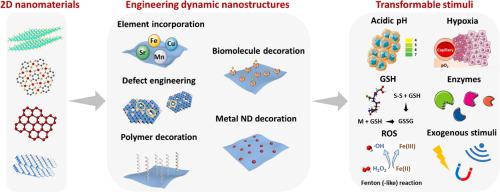Advanced Drug Delivery Reviews ( IF 15.2 ) Pub Date : 2021-11-01 , DOI: 10.1016/j.addr.2021.114031 Luyao Sun 1 , Jingjing Wang 1 , Li Li 1 , Zhi Ping Xu 1

|
Dynamic drug delivery systems (DDSs) have the ability of transforming their morphology and functionality in response to the biological microenvironments at the disease site and/or external stimuli, show spatio-temporally controllable drug delivery, and enhance the treatment efficacy. Due to the large surface area and modification flexibility, two-dimensional (2D) inorganic nanomaterials are being increasingly exploited for developing intelligent DDSs for biomedical applications. In this review, we summarize the engineering methodologies used to construct transformable 2D DDSs, including changing compositions, creating defects, and surface dot-coating with polymers, biomolecules, or nanodots. Then we present and discuss dynamic inorganic 2D DDSs whose transformation is driven by the diseased characteristics, such as pH gradient, redox, hypoxia, and enzyme in the tumor microenvironment as well as the external stimuli including light, magnetism, and ultrasound. Finally, the limitations and challenges of current transformable inorganic DDSs for clinical translation and their in vivo safety assessment are discussed.
中文翻译:

基于二维无机纳米粒子的动态纳米组件:构建和临床前演示
动态药物递送系统(DDS)具有响应疾病部位的生物微环境和/或外部刺激而改变其形态和功能的能力,显示出时空可控的药物递送,并提高治疗效果。由于大表面积和改性灵活性,二维(2D)无机纳米材料越来越多地被用于开发用于生物医学应用的智能DDS。在这篇综述中,我们总结了用于构建可变形二维 DDS 的工程方法,包括改变成分、产生缺陷以及用聚合物、生物分子或纳米点进行表面点涂层。然后我们提出并讨论动态无机二维 DDS,其转化是由疾病特征驱动的,如 pH 梯度、氧化还原、缺氧、肿瘤微环境中的酶以及光、磁、超声等外界刺激。最后,目前可转化无机 DDS 用于临床翻译的局限性和挑战及其讨论了体内安全性评估。











































 京公网安备 11010802027423号
京公网安备 11010802027423号